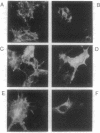Abstract
The monoclonal antibody PR1A3 has been used successfully for in vivo imaging of colorectal cancers, and several properties associated with this antibody, including minimal reactions of the antibody with circulating antigen in patients' sera, differentiate it from anti-carcinoembryonic antigen (CEA) antibodies used in similar studies. However, the antigen bound by PR1A3 was identified as CEA by analysis of somatic cell hybrids and by antigen expression from yeast artificial chromosomes, cosmids, and cDNA clones. The molecular weight, presence of a glycosyl-phosphatidylinositol anchor, elevation of surface expression by gamma-interferon, and N-terminal amino acid sequence all confirmed the antigen identification as CEA. A series of biliary glycoprotein-CEA hybrid proteins was produced which demonstrated that the epitope bound by the antibody was at the site of membrane attachment and involved parts of the glycosyl-phosphatidylinositol anchor and the B3 domain of CEA to form a conformational epitope. Access to this epitope, although possible when the antigen was on the cell surface, appeared to be blocked when CEA was released from the cell. The nature and location of the epitope on CEA are proposed to be responsible for the unique properties of the antibody.
Full text
PDF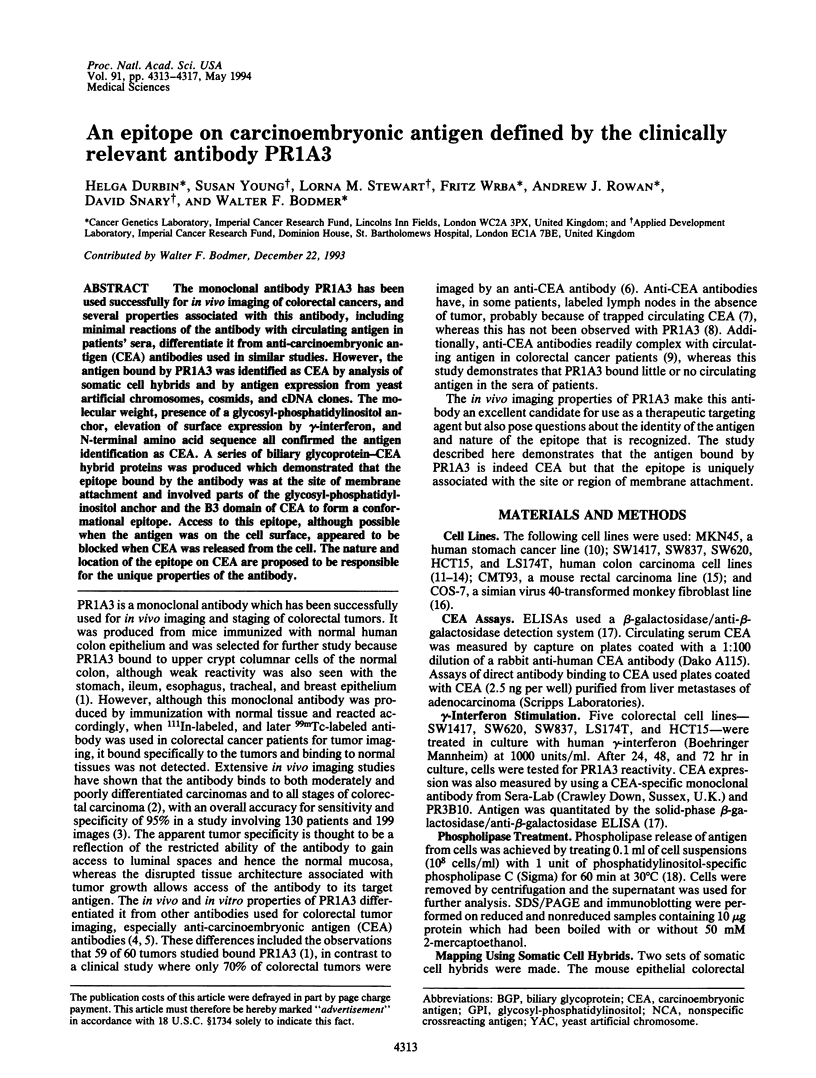
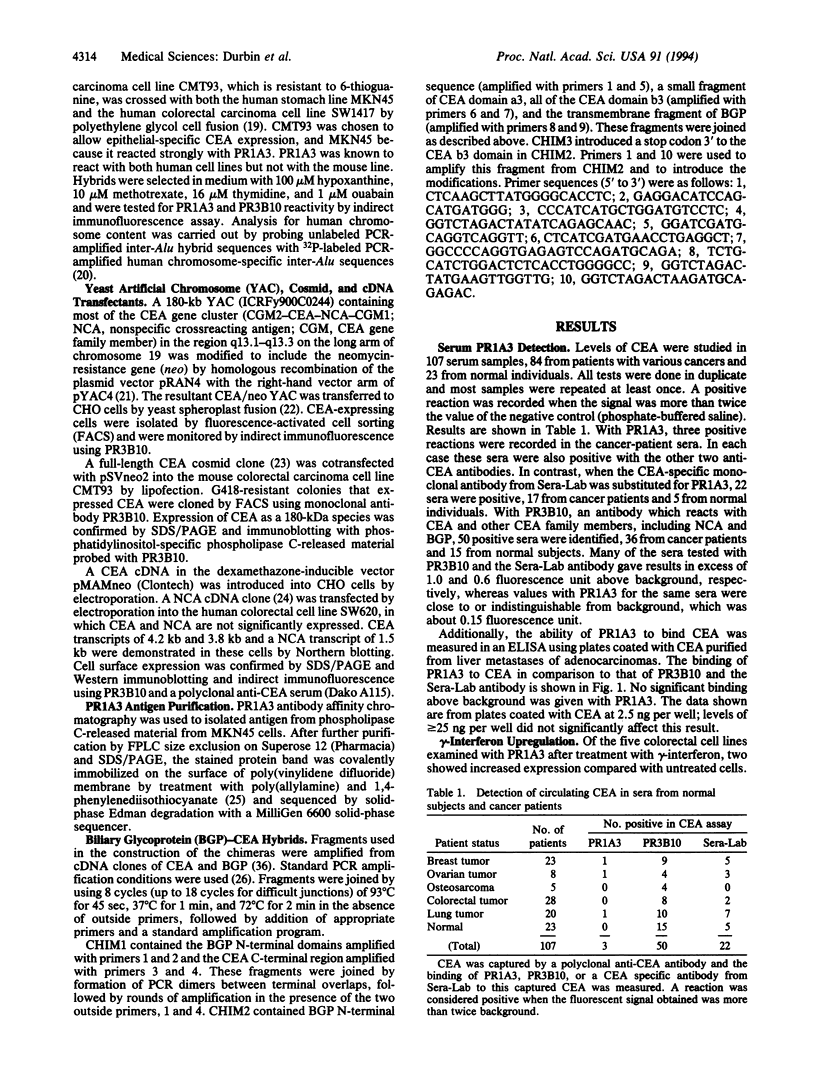
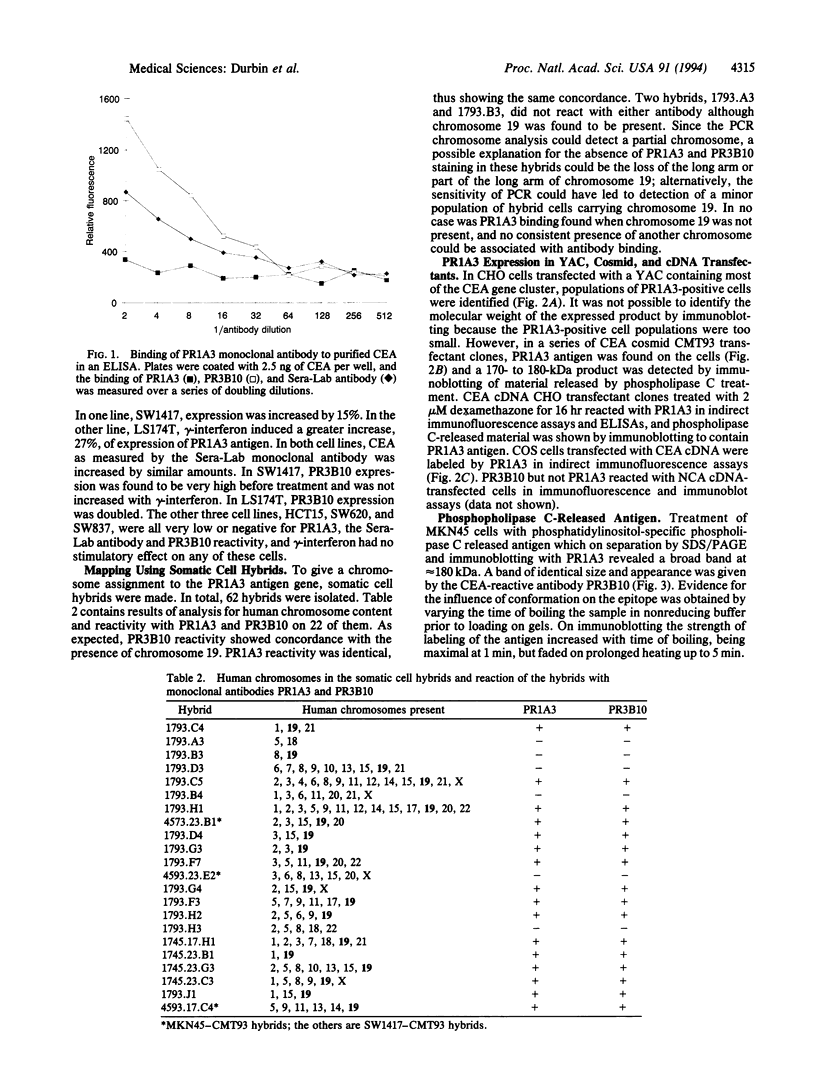
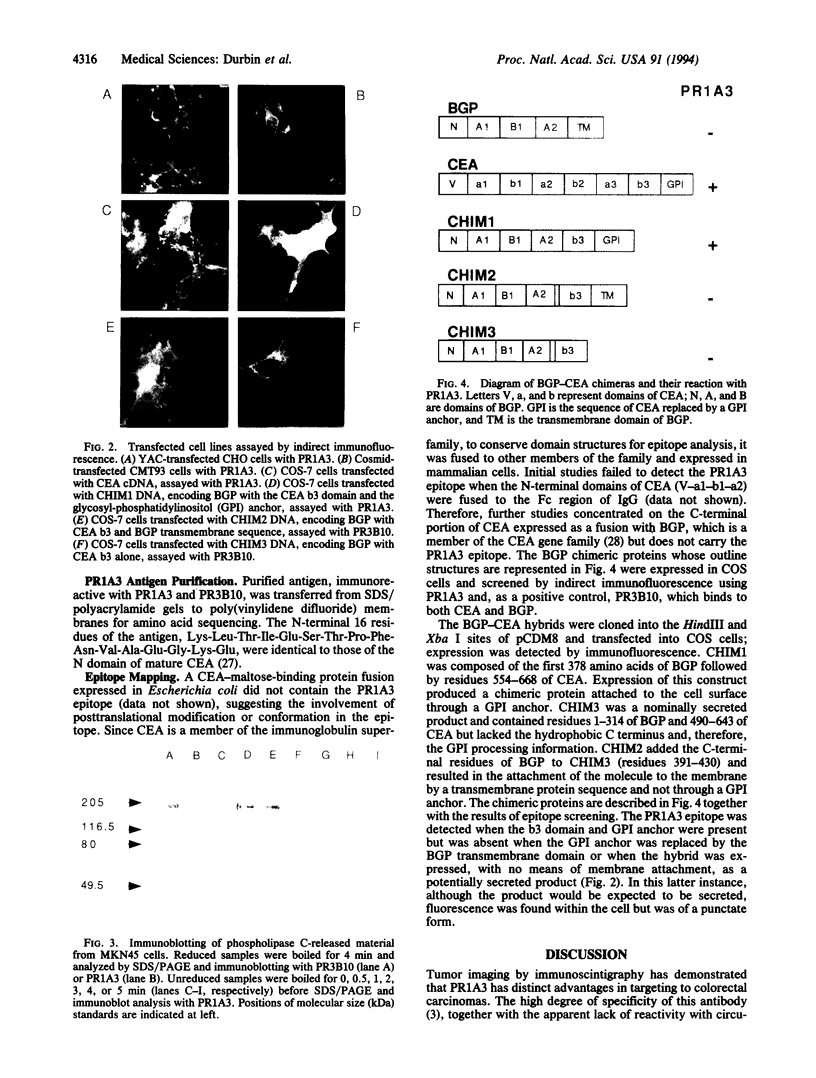
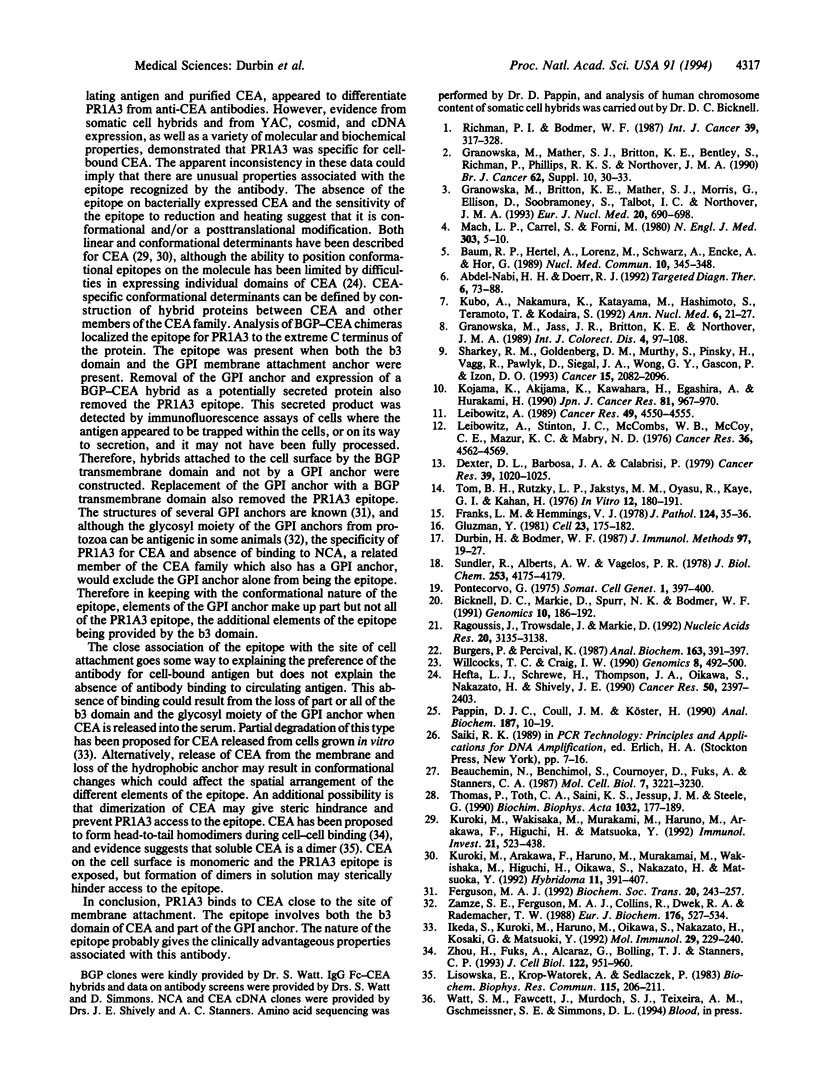
Images in this article
Selected References
These references are in PubMed. This may not be the complete list of references from this article.
- Abdel-Nabi H. H., Doerr R. J. Multicenter clinical trials of monoclonal antibody B72.3-GYK-DTPA 111In (111In-CYT-103; OncoScint CR103) in patients with colorectal carcinoma. Targeted Diagn Ther. 1992;6:73–88. [PubMed] [Google Scholar]
- Baum R. P., Hertel A., Lorenz M., Schwarz A., Encke A., Hör G. 99Tcm-labelled anti-CEA monoclonal antibody for tumour immunoscintigraphy: first clinical results. Nucl Med Commun. 1989 May;10(5):345–352. doi: 10.1097/00006231-198905000-00005. [DOI] [PubMed] [Google Scholar]
- Beauchemin N., Benchimol S., Cournoyer D., Fuks A., Stanners C. P. Isolation and characterization of full-length functional cDNA clones for human carcinoembryonic antigen. Mol Cell Biol. 1987 Sep;7(9):3221–3230. doi: 10.1128/mcb.7.9.3221. [DOI] [PMC free article] [PubMed] [Google Scholar]
- Bicknell D. C., Markie D., Spurr N. K., Bodmer W. F. The human chromosome content in human x rodent somatic cell hybrids analyzed by a screening technique using Alu PCR. Genomics. 1991 May;10(1):186–192. doi: 10.1016/0888-7543(91)90499-5. [DOI] [PubMed] [Google Scholar]
- Burgers P. M., Percival K. J. Transformation of yeast spheroplasts without cell fusion. Anal Biochem. 1987 Jun;163(2):391–397. doi: 10.1016/0003-2697(87)90240-5. [DOI] [PubMed] [Google Scholar]
- Dahiya R., Itzkowitz S. H., Byrd J. C., Kim Y. S. ABH blood group antigen expression, synthesis, and degradation in human colonic adenocarcinoma cell lines. Cancer Res. 1989 Aug 15;49(16):4550–4556. [PubMed] [Google Scholar]
- Dexter D. L., Barbosa J. A., Calabresi P. N,N-dimethylformamide-induced alteration of cell culture characteristics and loss of tumorigenicity in cultured human colon carcinoma cells. Cancer Res. 1979 Mar;39(3):1020–1025. [PubMed] [Google Scholar]
- Durbin H., Bodmer W. F. A sensitive micro-immunoassay using beta-galactosidase/anti-beta-galactosidase complexes. J Immunol Methods. 1987 Feb 26;97(1):19–27. doi: 10.1016/0022-1759(87)90100-1. [DOI] [PubMed] [Google Scholar]
- Ferguson M. A. Colworth Medal Lecture. Glycosyl-phosphatidylinositol membrane anchors: the tale of a tail. Biochem Soc Trans. 1992 May;20(2):243–256. doi: 10.1042/bst0200243. [DOI] [PubMed] [Google Scholar]
- Franks L. M., Hemmings V. J. A cell line from an induced carcinoma of mouse rectum. J Pathol. 1978 Jan;124(1):35–38. doi: 10.1002/path.1711240108. [DOI] [PubMed] [Google Scholar]
- Gluzman Y. SV40-transformed simian cells support the replication of early SV40 mutants. Cell. 1981 Jan;23(1):175–182. doi: 10.1016/0092-8674(81)90282-8. [DOI] [PubMed] [Google Scholar]
- Granowska M., Britton K. E., Mather S. J., Morris G., Ellison D., Soobramoney S., Talbot I. C., Northover J. M. Radioimmunoscintigraphy with technetium-99m labelled monoclonal antibody, 1A3, in colorectal cancer. Eur J Nucl Med. 1993 Aug;20(8):690–698. doi: 10.1007/BF00181760. [DOI] [PubMed] [Google Scholar]
- Granowska M., Jass J. R., Britton K. E., Northover J. M. A prospective study of the use of 111In-labelled monoclonal antibody against carcino-embryonic antigen in colorectal cancer and of some biological factors affecting its uptake. Int J Colorectal Dis. 1989;4(2):97–108. doi: 10.1007/BF01646868. [DOI] [PubMed] [Google Scholar]
- Granowska M., Mather S. J., Britton K. E., Bentley S., Richman P., Phillips R. K., Northover J. M. 99mTc radioimmunoscintigraphy of colorectal cancer. Br J Cancer Suppl. 1990 Jul;10:30–33. [PMC free article] [PubMed] [Google Scholar]
- Hefta L. J., Schrewe H., Thompson J. A., Oikawa S., Nakazato H., Shively J. E. Expression of complementary DNA and genomic clones for carcinoembryonic antigen and nonspecific cross-reacting antigen in Chinese hamster ovary and mouse fibroblast cells and characterization of the membrane-expressed products. Cancer Res. 1990 Apr 15;50(8):2397–2403. [PubMed] [Google Scholar]
- Ikeda S., Kuroki M., Haruno M., Oikawa S., Nakazato H., Kosaki G., Matsuoka Y. Epitope mapping of the carcinoembryonic antigen with various related recombinant proteins expressed in Chinese hamster ovary cells and 25 distinct monoclonal antibodies. Mol Immunol. 1992 Feb;29(2):229–240. doi: 10.1016/0161-5890(92)90104-6. [DOI] [PubMed] [Google Scholar]
- Koyama K., Akiyama K., Kawahara H., Egashira A., Murakami H. Alloimmunization with cultured human stomach cancer cell lines and the establishment of human-human hybridomas producing monoclonal antibodies. Jpn J Cancer Res. 1990 Oct;81(10):967–970. doi: 10.1111/j.1349-7006.1990.tb03332.x. [DOI] [PMC free article] [PubMed] [Google Scholar]
- Kubo A., Nakamura K., Katayama M., Hashimoto S., Teramoto T., Kodaira S. Pharmacokinetic analysis of antibody localization in human colon cancer: comparison with immunoscintigraphy. Ann Nucl Med. 1992 Feb;6(1):21–27. doi: 10.1007/BF03164638. [DOI] [PubMed] [Google Scholar]
- Kuroki M., Arakawa F., Haruno M., Murakami M., Wakisaka M., Higuchi H., Oikawa S., Nakazato H., Matsuoka Y. Biochemical characterization of 25 distinct carcinoembryonic antigen (CEA) epitopes recognized by 57 monoclonal antibodies and categorized into seven groups in terms of domain structure of the CEA molecule. Hybridoma. 1992 Aug;11(4):391–407. doi: 10.1089/hyb.1992.11.391. [DOI] [PubMed] [Google Scholar]
- Kuroki M., Wakisaka M., Murakami M., Haruno M., Arakawa F., Higuchi H., Matsuoka Y. Determination of epitope specificities of a large number of monoclonal antibodies by solid-phase mutual inhibition assays using biotinylated antigen. Immunol Invest. 1992 Oct;21(6):523–538. doi: 10.3109/08820139209069388. [DOI] [PubMed] [Google Scholar]
- Leibovitz A., Stinson J. C., McCombs W. B., 3rd, McCoy C. E., Mazur K. C., Mabry N. D. Classification of human colorectal adenocarcinoma cell lines. Cancer Res. 1976 Dec;36(12):4562–4569. [PubMed] [Google Scholar]
- Lisowska E., Krop-Watorek A., Sedlaczek P. The dimeric structure of carcinoembryonic antigen (CEA). Biochem Biophys Res Commun. 1983 Aug 30;115(1):206–211. doi: 10.1016/0006-291x(83)90990-7. [DOI] [PubMed] [Google Scholar]
- Mach J. P., Carrel S., Forni M., Ritschard J., Donath A., Alberto P. Tumor localization of radiolabeled antibodies against carcinoembryonic antigen in patients with carcinoma: a critical evaluation. N Engl J Med. 1980 Jul 3;303(1):5–10. doi: 10.1056/NEJM198007033030102. [DOI] [PubMed] [Google Scholar]
- Pappin D. J., Coull J. M., Köster H. Solid-phase sequence analysis of proteins electroblotted or spotted onto polyvinylidene difluoride membranes. Anal Biochem. 1990 May 15;187(1):10–19. doi: 10.1016/0003-2697(90)90410-b. [DOI] [PubMed] [Google Scholar]
- Pontecorvo G. Production of mammalian somatic cell hybrids by means of polyethylene glycol treatment. Somatic Cell Genet. 1975 Oct;1(4):397–400. doi: 10.1007/BF01538671. [DOI] [PubMed] [Google Scholar]
- Ragoussis J., Trowsdale J., Markie D. Mitotic recombination of yeast artificial chromosomes. Nucleic Acids Res. 1992 Jun 25;20(12):3135–3138. doi: 10.1093/nar/20.12.3135. [DOI] [PMC free article] [PubMed] [Google Scholar]
- Richman P. I., Bodmer W. F. Monoclonal antibodies to human colorectal epithelium: markers for differentiation and tumour characterization. Int J Cancer. 1987 Mar 15;39(3):317–328. doi: 10.1002/ijc.2910390309. [DOI] [PubMed] [Google Scholar]
- Sharkey R. M., Goldenberg D. M., Murthy S., Pinsky H., Vagg R., Pawlyk D., Siegel J. A., Wong G. Y., Gascon P., Izon D. O. Clinical evaluation of tumor targeting with a high-affinity, anticarcinoembryonic-antigen-specific, murine monoclonal antibody, MN-14. Cancer. 1993 Mar 15;71(6):2082–2096. doi: 10.1002/1097-0142(19930315)71:6<2082::aid-cncr2820710625>3.0.co;2-q. [DOI] [PubMed] [Google Scholar]
- Sundler R., Alberts A. W., Vagelos P. R. Enzymatic properties of phosphatidylinositol inositolphosphohydrolase from Bacillus cereus. Substrate dilution in detergent-phospholipid micelles and bilayer vesicles. J Biol Chem. 1978 Jun 25;253(12):4175–4179. [PubMed] [Google Scholar]
- Thomas P., Toth C. A., Saini K. S., Jessup J. M., Steele G., Jr The structure, metabolism and function of the carcinoembryonic antigen gene family. Biochim Biophys Acta. 1990 Dec 11;1032(2-3):177–189. doi: 10.1016/0304-419x(90)90003-j. [DOI] [PubMed] [Google Scholar]
- Tom B. H., Rutzky L. P., Jakstys M. M., Oyasu R., Kaye C. I., Kahan B. D. Human colonic adenocarcinoma cells. I. Establishment and description of a new line. In Vitro. 1976 Mar;12(3):180–191. doi: 10.1007/BF02796440. [DOI] [PubMed] [Google Scholar]
- Willcocks T. C., Craig I. W. Characterization of the genomic organization of human carcinoembryonic antigen (CEA): comparison with other family members and sequence analysis of 5' controlling region. Genomics. 1990 Nov;8(3):492–500. doi: 10.1016/0888-7543(90)90036-t. [DOI] [PubMed] [Google Scholar]
- Zamze S. E., Ferguson M. A., Collins R., Dwek R. A., Rademacher T. W. Characterization of the cross-reacting determinant (CRD) of the glycosyl-phosphatidylinositol membrane anchor of Trypanosoma brucei variant surface glycoprotein. Eur J Biochem. 1988 Oct 1;176(3):527–534. doi: 10.1111/j.1432-1033.1988.tb14310.x. [DOI] [PubMed] [Google Scholar]
- Zhou H., Fuks A., Alcaraz G., Bolling T. J., Stanners C. P. Homophilic adhesion between Ig superfamily carcinoembryonic antigen molecules involves double reciprocal bonds. J Cell Biol. 1993 Aug;122(4):951–960. doi: 10.1083/jcb.122.4.951. [DOI] [PMC free article] [PubMed] [Google Scholar]



